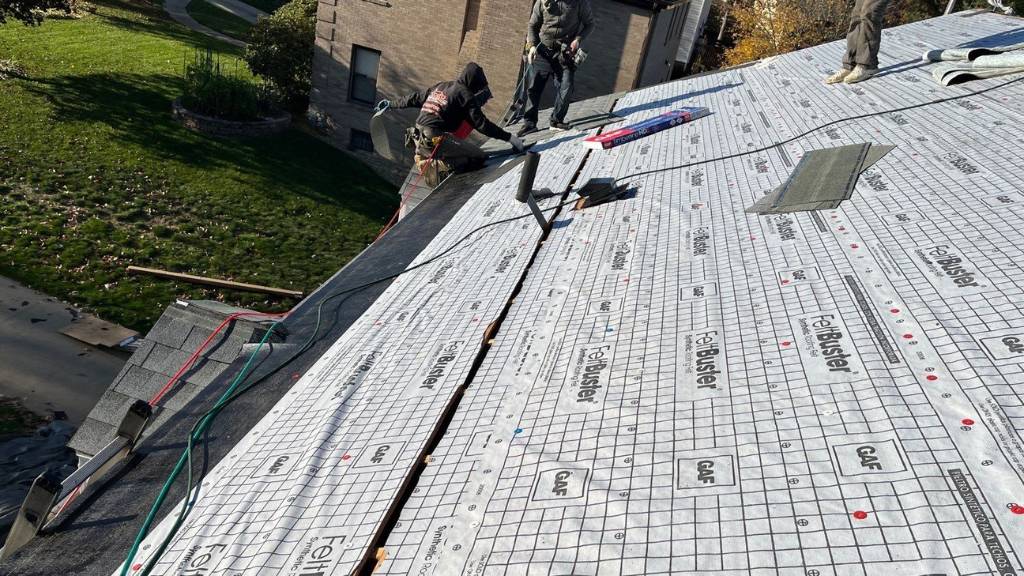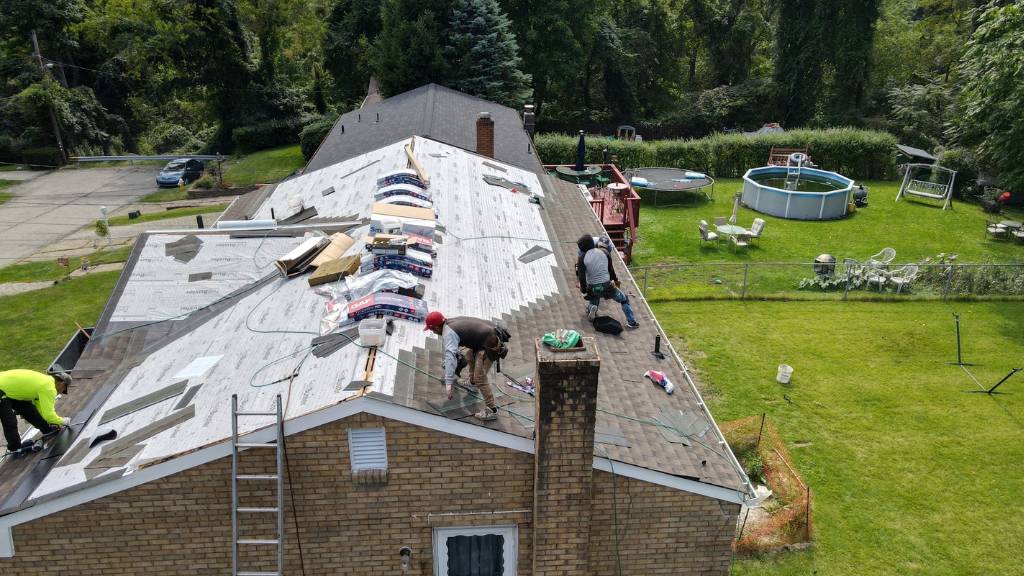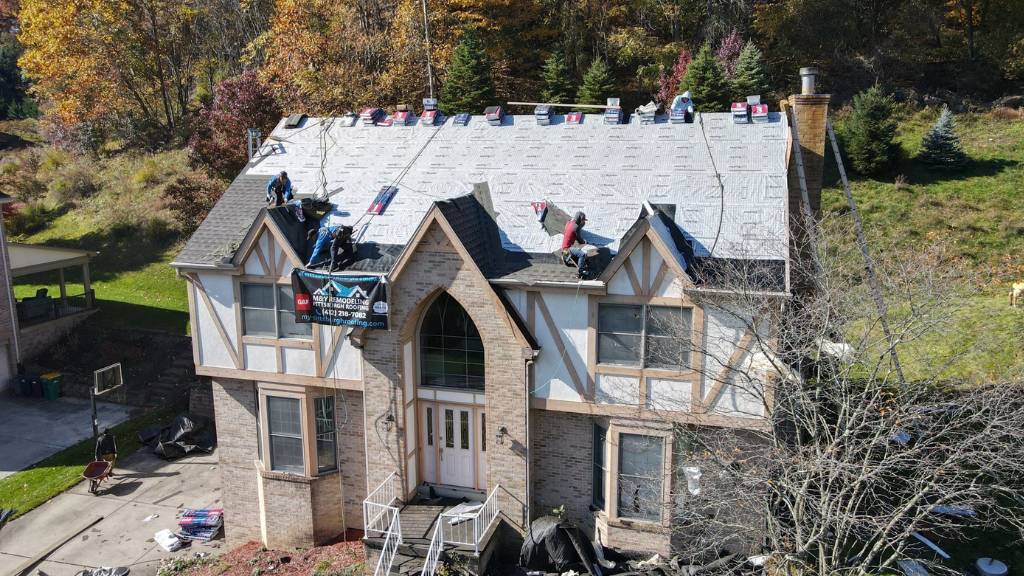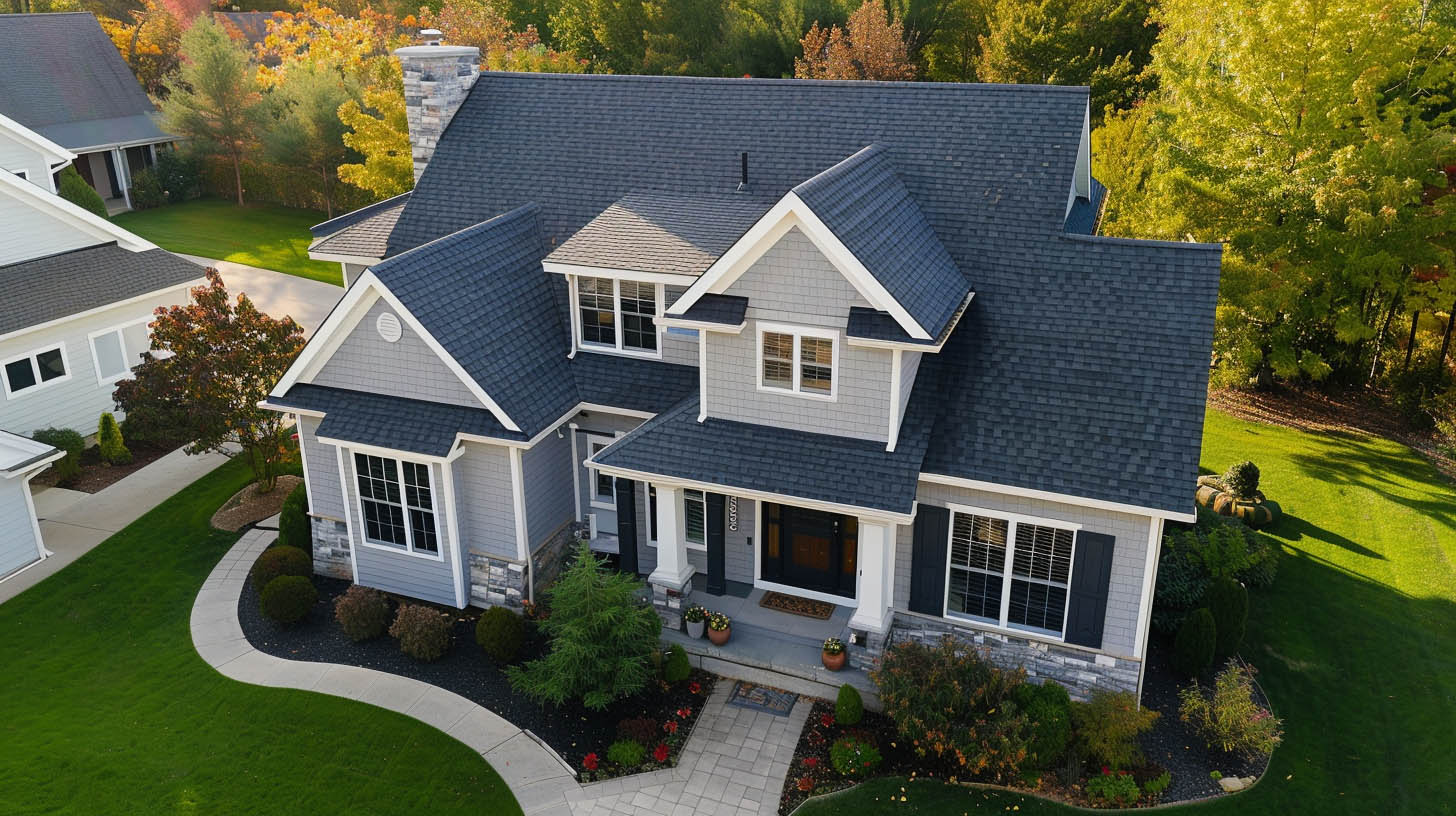
Let’s take a deep dive into everything you need to know about:
- Roof underlayment, including what it is, the materials used, and why it’s important.
- The roofing underlayment types, how to choose the right underlayment, and the installation process.
- Hidden dangers of having no roofing underlay.
What is Roof Underlayment & Why is it Important?

Underlayment is typically made from a waterproof material, such as asphalt-saturated felt, synthetic polymers, or rubberized asphalt. These materials are designed to be highly resistant to water penetration, ensuring that the roof deck remains dry even in heavy rain or snowfall. Often called roof sheathing, underlayment consists of materials such as step sheathing, OSB, or plywood.
Roof Underlayment and What it Prevents
Extreme temperatures can be prevented by roof underlayment. So can UV rays, hail, and other harmful elements. It has been proven to also extend the life of your roof in general.Additionally, it is always best to check with a professional roofer before attempting to DIY a project of this nature. It is not recommended because most home owners are amateurs when it comes to the tools and education needed to install roof underlayment.
Metal Roof Disadvantages
One of the biggest disadvantages to the metal roof is the cost. Metal roofs can be two to three times the cost of a traditional shingle roof. Another disadvantage is the noise. A metal roof can be quite noisy during a rainstorm or when hail hits. And finally, metal roofs are not as easy to repair as a traditional shingle roof.Leaks & Water Damage
An essential component of any roofing system is roof underlayment. It provides an additional layer of protection against water penetration, which is one of the primary causes of roof damage. Water can seep through the smallest of cracks in the roofing material, which can lead to leaks and water damage inside the home.Unwanted Heat and Cold
In addition to protecting against water damage, roof underlayment can also provide additional insulation to the roof deck. This can help to keep the home cooler in the summer and warmer in the winter, reducing energy costs and improving overall comfort.Premature Breakdown of the Entire Roofing Structure
Another benefit of roof underlayment is that it can improve the overall durability of the roofing system. By providing an additional layer of protection, it can help to extend the lifespan of the roof, reducing the need for repairs or replacement.Damage from High Winds
If you live in an area prone to tornados or hurricanes, do not take roof underlayment lightly. Roof underlay is your only protection if the shingles get torn away from your roof during a storm.Damage from Ice Dams
Areas prone to frigid temps during the winter mean that roofs are susceptible to ice dams. Ice dams can severely damage your roof without an extra layer of protection provided by roofing underlayment.Damage from Roof Replacement
It is crucial that your underlayment be secure during the installation process of shingle attachment. Otherwise, your home could be damaged from rain or bad weather before all of the shingles are attached.Roofing Underlayment Types

Asphalt-Saturated Felt
Asphalt-saturated felt, also known as tar paper, is one of the most commonly used types of roof underlayment. It is made from a base material, such as cellulose or fiberglass, that is coated with asphalt to make it waterproof. Asphalt-saturated felt is also relatively inexpensive, easy to install, and provides good protection against water penetration. However, it is not as durable as some of the other types of underlayment and may need to be replaced more frequently.Synthetic Roof Underlayment
Synthetic polymer underlayment is a newer type of underlayment that is gaining popularity due to its excellent performance and durability. It is made from a variety of materials, including polyethylene, polypropylene, and polyester, that are designed to be highly resistant to water penetration. Not only that, but it can last up to 50 years. Synthetic underlayment is also lightweight, easy to install, and can be used with a wide range of roofing materials.Be aware of problems with synthetic roof underlayment. Although synthetic roofing underlayment is becoming an increasingly popular choice in roofing, there are a number of potential problems that can arise with it. From durability issues to a lack of breathability, synthetic underlayment could be more trouble than it’s worth. It’s typically made from polyethylene, which is more prone to tearing than other materials. This can be especially problematic in areas with high winds or hailstorms. It also tends to be more expensive.
Rubberized Asphalt
Rubberized asphalt underlayment is a type of underlayment that is made from a blend of asphalt and synthetic rubber. It is designed to be highly flexible and durable, making it an excellent choice for areas with high levels of temperature and weather fluctuations. Rubberized asphalt underlayment is more expensive than asphalt-saturated felt but offers better protection against water damage and is more durable.Self-adhered Underlayment
Self-adhered underlayment is a type of roofing underlayment that can be applied directly to a roof deck or substrate without the need for mechanical fasteners. It is made from a flexible and durable material that is coated with a layer of adhesive on one side. The adhesive layer allows the underlayment to stick firmly to the roof deck, creating a watertight seal. Some common materials used for self-adhered underlayment include modified bitumen, rubberized asphalt, and synthetic polymers. The choice of material depends on the specific needs of the roofing project, such as the type of roofing material being installed and the climate of the region.Synthetic Underlayment Vs. Felt Underlayment
Synthetic roof underlayment and felt roof underlayment are both materials that are installed on top of the roof deck but underneath the final roofing material. Here are the differences between the two:- Material: Felt roof underlayment is made of organic materials such as wood, cellulose, or fiberglass, whereas synthetic roof underlayment is made of synthetic materials such as polypropylene, polyester, or fiberglass.
- Weight: This type of underlayment is heavier than synthetic roof underlayment. This means that it can be more difficult to handle and install, especially in windy conditions.
- Durability: Synthetic roof underlayment is generally more durable than felt roof underlayment. It is less likely to tear or be damaged by exposure to the elements, and can provide better protection against leaks.
- Breathability: Felt roof underlayment is more breathable than synthetic roof underlayment. This means that it allows moisture to escape from the attic or roof cavity, which can help prevent mold and mildew growth.
- Cost: Synthetic roof underlayment is generally more expensive than felt roof underlayment. However, the increased durability and water resistance may justify the additional cost.
Roof Underlayment Brands
There are several reputable roof underlayment brands available in the market, some of which include:Deck-Armor™ or GAF
Fun fact: Believe it or not, the term “deck armor” is commonly referred to as the protective layer that covers the deck of a ship to resist damage from various sources such as heavy seas, impacts, and fire. As you can imagine, this is where the brand Deck-Armor comes into play for the protection of a home’s roofing system.In a nutshell, Deck-Armor™ offers premium deck protection of roofing systems so that your home is safeguarded from wind and rain that can oftentimes trap moisture. This product can ultimately be a fantastic protection against:
- Mold
- Mildew
- Rot
Tiger Paw™
If you are looking for a top-notch protection for your roof, Tiger Paw™ is just this. It offers top-notch protection for your roof. This high-quality, synthetic underlayment is designed with moisture control in mind, effectively reducing the moisture content on your roof deck. It provides a sturdy layer of defense against wind-driven rain, which can cause significant damage to both your roof structure and the interior of your home. Suitable for a wide range of roofing materials:- Asphalt Shingles
- Slate
- Wood
- Metal and Mechanically Attached Tile Roofs
- UV-Stabilized
- Moisture-Control Design
- Protects Against Wind-Driven Rain
FeltBuster®
Otherwise known as the best bang for your buck, FeltBuster® is a polypropylene underlayment and is affordably priced to boot. This underlayment sits flatter than conventional felt, resulting in a stylish and sleek roof appearance. Its robust design enables it to:- Withstand Tearing
- Resist Moisture Absorption
Shingle-Mate®
If you’re interested in a type of roofing felt reinforced with fiberglass, you might want to consider Shingle-Mate® Fiberglass-Reinforced Roof Deck Protection. Traditional asphalt felts can become wrinkled or form bubbles upon exposure to moisture, which can mar the appearance of your completed roof. However, Shingle-Mate’s fiberglass reinforcement keeps it flat and reduces wrinkling, resulting in a polished and professional finish.This particular product serves as an additional safeguard against:- Rain Driven Winds
- Wrinkles
- Bubbling
VersaShield®
By using Versa Shield®, you get a fire-proof protection to your roof deck. In fact, it gives you a superior UL fire rating. UL fire rating is a measure of fire safety and resistance used to classify the ability of different building materials to resist fire. So, the perks include:- Superior UL Fire Rating
- Defense Against Wind-Driven Rain
- Fiberglass Reinforcement
Pros & Cons of Synthetic Roofing Underlayment
Synthetic roofing underlayment is an alternative to traditional felt paper underlayment that is made from asphalt-saturated felt and offers several advantages and disadvantages compared to felt paper underlayment.Advantages
- Superior Durability: Synthetic underlayment is more durable and can withstand harsh weather conditions such as extreme temperatures, high winds, and heavy rain or snow. It is also resistant to tearing and punctures, which means it can better protect the roof deck.
- Lighter Weight: It is much lighter in weight compared to traditional felt paper, making it easier to install and handle. It can also reduce the overall weight load on the roof structure.
- Water Resistance: Synthetic underlayment is also highly water-resistant, which means it can provide better protection against leaks and moisture damage.
- Breathability: Some synthetic underlayments have built-in breathability features, which allow moisture to escape from the roof deck, reducing the risk of rot and mold growth.
- Higher Cost: Synthetic underlayment is generally more expensive than traditional felt paper underlayment, which may make it less cost-effective for some homeowners.
- Slipperiness: Some types of synthetic underlayment can be quite slippery, especially when wet, which can make installation and maintenance more challenging.
- Water Resistance: This type of underlayment is highly water-resistant, which means it can provide better protection against leaks and moisture damage.
- Environmental Impact: Synthetic underlayment is made from non-biodegradable materials, which means it may have a negative environmental impact if not disposed of properly.
- UV Resistance: Some synthetic underlayments are not UV resistant, which means they may break down more quickly when exposed to direct sunlight. This could reduce the lifespan of the underlayment and may require more frequent replacement.
Pros & Cons of Felt Roofing Underlayment
Is roofing felting really necessary? Truth be told, felt roofing underlayment is a popular choice for many roofing projects. Roofing felt has been a recommended component for roofing and waterproofing by organizations like the National Roofing Contractors Association (NRCA) and the Canadian Asphalt Shingle Manufacturer’s Association (CASMA) for over 25 years. Furthermore, it is mandatory to include it in many building codes. Here are some of the pros and cons to consider:Advantages
- Affordable: Felt underlayment is generally more affordable than other types of roofing underlayment.
- Water-resistant: Underlayment made of felt is water-resistant and can help protect the roof from water damage.
- Easy to install: Felt underlayment is also relatively easy to install, making it a good option for DIY roofing projects.
- Durable: It is a durable material that can withstand exposure to the elements.
- Acts as a secondary barrier: Felt underlayment can serve as a secondary barrier between the roof deck and the shingles, which can help protect against leaks. Disadvantages
- Prone to tears: This type of underlayment can tear easily during installation, which can compromise its effectiveness as a water barrier.
- Limited lifespan: A limited lifespan compared to other types of roofing underlayment is common, such as synthetic or rubber.
- Vulnerable to UV damage: Felt underlayment is vulnerable to UV damage, which can cause it to break down and lose its effectiveness over time.
- Susceptible to mold and mildew: It can be susceptible to mold and mildew growth if it gets wet and doesn’t dry out properly.
- Limited moisture protection: Felt underlayment provides some moisture protection, but it’s not as effective as other types of underlayment, such as rubber.
- Flashing: Flashing is a thin material (usually metal) that is installed at the intersection of two roofing surfaces or around roof penetrations such as chimneys, vents, and skylights. Water can seep in if the flashing is not installed properly.
- Valleys: A valley is the area where two sloping roof planes meet. If the shingles or other roofing material in the valley are not installed correctly or become damaged, they can allow water to penetrate the roof.
- Vents: Roof vents are installed to allow air to circulate through the attic and help regulate the temperature and humidity. However, if the flashing around the vent is not installed properly or becomes damaged, it can allow water to seep in.
- Edges: The edges of a roof are particularly vulnerable to leaks, especially if the roofing material is not installed properly or becomes damaged. Water can enter the roof through gaps or holes in the edge flashing or by seeping under the shingles or other roofing material.
- Skylights: Skylights are a popular feature in many homes and can provide natural light to interior spaces. However, if the flashing around the skylight is not installed properly or becomes damaged, it can allow water to seep in and cause a leak.
- Improper installation: Improperly installed underlayment can result in water damage, which can affect the structural integrity of your roof and lead to expensive repairs.
- Safety hazards: Installing underlayment involves working at heights, which can be dangerous without the proper safety equipment and training. Falls from roofs can result in serious injury or even death.
- Warranty issues: If you install the underlayment yourself, it may void the manufacturer’s warranty, which could leave you responsible for the cost of any future repairs or replacement.
- Time-consuming and costly mistakes: If you make a mistake during the installation process, you may need to start over, which can be both time-consuming and costly.
Common Leak-Prone Areas on Roofs
As you’ve learned, roof underlayment helps prevent a variety of issues with your roofing system, including leaks. There are several common leak-prone areas on roofs, so it’s important that your underlayment is properly protecting the following:Can I Install Roof Underlayment Myself?
Installing roof underlayment is a crucial step in the roofing process and it requires proper knowledge, skills, and tools. While it is possible to install roof underlayment yourself, it is highly recommended to hire a professional roofing contractor to ensure that the installation is done correctly and to avoid any potential safety hazards – otherwise you risk costly mistakes.Think about it: Professional roofers have the expertise and experience to properly install underlayment, which can help prevent water damage and prolong the life of your roof. Additionally, professional roofers have access to high-quality materials and equipment, which can further ensure the proper installation of the underlayment.
The Downfalls of Installing Roof Underlayment Yourself
If you were to install roof underlayment yourself without proper knowledge, skills, and tools, it could lead to several potential issues:


